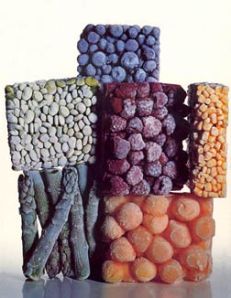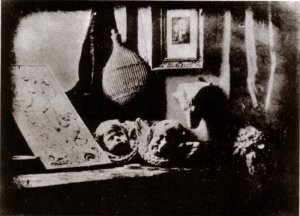 I recently got a book out of the library about Irving Penn’s still life photography. The image on the front is what took my fancy when I saw the book on line. Silly me thought the book would be full of spectacular botanical imagery, just like the front cover (it is an image of stacked frozen blocks of fruit and veges, see to left). I was disappointed from that perspective, but did enjoy the book and got some gems out of it, both from the essay at the start and the images. The gems from the essay were: First still life photographed was by Nicephore Niepce around 1827, it was a picture of a table set for a simple meal for one. http://www.larousse.fr/encyclopedie/personnage/Ni%C3%A9pce/135269 So simple in todays terms, but then it would have been something unusual to photograph back then. It is a really grainy image and the bread ‘feels’ stale looking at it now.It would also have been unusual to have taken an image of a single place setting, considering families were a lot larger than they are today. But when reading that many images took 8 hours of exposure, it is no wonder he started with this. Louis-Jacques-Mande Daguerre made a still life in 1837.
I recently got a book out of the library about Irving Penn’s still life photography. The image on the front is what took my fancy when I saw the book on line. Silly me thought the book would be full of spectacular botanical imagery, just like the front cover (it is an image of stacked frozen blocks of fruit and veges, see to left). I was disappointed from that perspective, but did enjoy the book and got some gems out of it, both from the essay at the start and the images. The gems from the essay were: First still life photographed was by Nicephore Niepce around 1827, it was a picture of a table set for a simple meal for one. http://www.larousse.fr/encyclopedie/personnage/Ni%C3%A9pce/135269 So simple in todays terms, but then it would have been something unusual to photograph back then. It is a really grainy image and the bread ‘feels’ stale looking at it now.It would also have been unusual to have taken an image of a single place setting, considering families were a lot larger than they are today. But when reading that many images took 8 hours of exposure, it is no wonder he started with this. Louis-Jacques-Mande Daguerre made a still life in 1837.  image ref http://en.wikipedia.org/wiki/File:Daguerreotype_Daguerre_Atelier_1837.jpg This is a very eerie image, as it has 2 babies heads in it, very real looking. It makes me wonder why Daguerre felt compelled to add these 2 amongst the other items. As Szarkowski says in the essay: “These first attempts appear to be remarkably good and you could be forgiven to think that by the now this style would have been exhausted. That the whole idea would be solved, with no new ways of approaching it. On the contrary it is still full of life and possibilities and Penn certainly demonstrates this.” Many of us still now play with still life, Fiona Pardington is one example of a NZ photographer who still challenges this genre within her work.
image ref http://en.wikipedia.org/wiki/File:Daguerreotype_Daguerre_Atelier_1837.jpg This is a very eerie image, as it has 2 babies heads in it, very real looking. It makes me wonder why Daguerre felt compelled to add these 2 amongst the other items. As Szarkowski says in the essay: “These first attempts appear to be remarkably good and you could be forgiven to think that by the now this style would have been exhausted. That the whole idea would be solved, with no new ways of approaching it. On the contrary it is still full of life and possibilities and Penn certainly demonstrates this.” Many of us still now play with still life, Fiona Pardington is one example of a NZ photographer who still challenges this genre within her work.
Other still life artist that the book reminded me of are: Jean-Baptiste Chardin or Paul Cezanne it is said he arranged his fruit behind his back, so that not to fall into the traditional trap and have conventional arrangements (pg 4 of the essay) or Juan Sanchez Cotan, a spanish painter Still life is not something that I have thought about serious within my practice, but I do think that much of what I work with, both process and content lends itself to this approach. Certainly my bottle series were very much a still life approach. The following passage from the essay interested me, especially after seeing the work of Cotan. HIs unusual way of suspending fruit or vegetables in space, while creating this line up that reminds me of ‘who is the guilty one’. Each piece within the frame appears to be carefully arranged, in a comical way:“The french in their devotion to pictorial clarity and logic, generally required that the apple and the table on which it sits, and the air that surrounds them both, constitute and individual visual field, into which the parts are subsumed.The spanish still life the apple tends to be an actor on stage, distinct from and superior to it. There is the kind of corporeal weight, an earthbound specificity, a gravity, in the Spanish fruit or nut that prevents it from becoming wholly absorbed into the visual field” (pg 7) This description of the difference between the French and Spanish still life explanins it very well. The fact that Penn was a master at both still life and portraiture was amazing, as each of these has its own challenges. Szarkowski used some simple comparisons to explain the differences between the two genre, I have simplified them even more:Portraiture -
- Portraiture in which the artist control is most compromised by the will of the subject (pg 2)
- Best portraitist maybe those who are successful at establishing a psychic exchange, a current of mutual interest, between themselves and the sitter.(pg 2)
- A portrait is a battle between 2 wills for the control of the sitters soul.
- The best portrait would be the ones where the artist wins in a hard won contest, not an easy won one.
- You get raw material in the form of a human, which is wonderous beyond comprehension - so the photographer needs to bring out the unique wonder in some significant way, to help distinguish this sitter form the may others.(pg 3)
- It is challenging to get the sitter to occupy the frame just ‘right’ - the gesture of the eyes, head, shoulder and facial muscles creates the expression (pg 3)
Still life:
- Is the genre in which the artist has the highest degree of control over their subject (pg 2)
- You get dead apples, game, skulls, a collection of objects seldom addressed in poetic places.
- The stuff of still life is unique, but interest us only as exemplars of a more or less undifferentiated class.(pg 3)
- With all these items you have absolute control, they are submissive subjects. We can place them where and how we wish, they will stay there and only slump ever so slowly. (pg 4)
- It is said that their submissiveness makes them difficult to work with (pg 4)
These simple differences make me understand why for me still life/botanical imagery is so appealing. Szarkowski goes on to say that “the bravest of artist do not spend their time engaged in one genre alone. As making serious portraits each day becomes a tedium, as a change can be seen as a rest.” (pg 3) I have over time tried to do some people photography, as I find faces beautiful and fascinating. They hold so much of the person, their history, pain, joys and acceptance (or not) of their looks. It maybe something I investigate further at some stage or do alongside other work. I need to aim to get this same depth of history etc out of the botanical imagery I produce.
It was interesting to note that “before 1972 most of Penn’s still lives were principally out of good things to eat and drink, after 1972 he started to photograph trash”. Once I had flicked through the book and noted which images felt ‘magazine like’ and which felt more art like without looking at the titles, the more art-like were freer, they felt less constructed, which is strange, as the content of these and the way they were photographed certainly would have been just as constructed as the editorial imagery.
Images from the book that appealed: Frozen food with string beans NY 1977 - this is an editorial image, but the appeal is the unusual way of capturing fruit and vegetables. Pear with seeds NY 1993 - it looks like a happy face, only trouble is you keep looking for the mouth. Wormy apples NY 1985 - how can a bunch of unwanted, probably disregarded apples look so attractive. Bird bones, from an island in Sweden. NY 1980. Collapse, composition of falling steel pieces. NY 1980. In this image you can feel the weight, the heaviness of the objects, as they are balancing together. Bone landscape, NY 1980. Edifice (a construction of bones) NY 1979. Having a dog I can relate to this stack, not sure if I now want to go and collect his discarded bones. Single oriental poppy, editorial photo for Vogue. NY 1968. Poppies are always beautiful, whether they are perfect or otherwise. The whole flower and then the seed head have this strong structure about them which makes them magical.
References used: Still Life Irving Penn Photography 1938 - 2000 intro by John Szarkowski, (2001) London, UK. Thames & Hudson
and the weblinks I have added within this post
